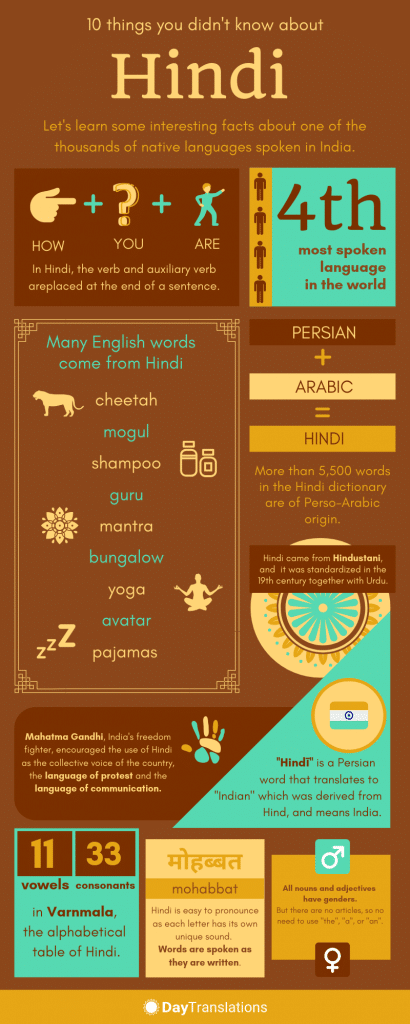The facts about the Hindi language show that it is an old language that has its own history and period of development. Hindi, which is one of the languages spoken in India, belongs to the Indo-European language family just like English. Today it is the fourth most spoken language in the world, according to the 21st edition of Ethnologue. It is principally spoken in four countries. About 341 million people speak Hindi as their first language. Overall, around 615.5 million people worldwide speak Hindi.
September 14 is considered as Hindi Day or Hindi Divas, a special day to celebrate the adoption of Hindi written in the Devanagari script as India’s official language. The occasion marks September 14, 1949, the 50th birthday of Beohar Rajendra Simha, a Hindi scholar who worked to push the language as the official language of India. It’s the same date when the Constituent Assembly of India approved the adoption of the language.
While Hindi comes from the Indo-European language family, it should be noted that so many languages are spoken in India and they belong in different language families. The major ones are Indo-Aryan languages and Dravidian languages, as well as Austroasiatic, Tai-Kadai and Sino-Tibetan languages. The country ranks second to Papua New Guinea in terms of the number of languages spoken.
India Does Not Have a National Language
Among the interesting facts about Hindi, this is the most significant – it is not a national language. In fact, India does not have a national language, but Hindi and English are recognized as official languages. English is used by the government for administrative purposes. On the other hand, Hindi is a very popular language that many people think that it is India’s national language.
However, the different states in India are allowed to choose between English and Hindi as their official language via legislation. The Constitution also recognizes 22 regional languages, including Hindi as scheduled languages. According to Ethnologue, the current list of languages in India includes 447 individual living languages.
Regional Languages
As of 2017, India is home to 1.339 billion and with the size of the Indian subcontinent, it is not difficult to understand that a variety of languages would be spoken in different regions. The most popular regional languages are Telugu, Tamil, Urdu and Kannada.
Aside from the regional languages, India has several immigrant languages, such as Arabic, Judeo-Iraqi Arabic, Rohingya, Iranian Persian, Chinese, Burushaski, Western Armenian and Uyghur.
You’ve just had a glimpse of the interesting facts about the Hindi language, so let’s talk about the rest.
Awesome Facts About the Hindi Language
If you are planning to learn Hindi, interested in India’s history, or thinking of visiting India in the future, it is always a good idea to know about the country’s language. The local language says more about the culture of the population. So here are some interesting facts about Hindi to whet your appetite.
1. Origin of Hindi
Hindi came from Hindustani that is spoken in North India. It was standardized in the 19th century together with Urdu. These two languages have many similarities and many consider them as variants of the original language, Hindustani.
2. Wide range of speakers
Hindi is a very popular language, being the fourth most spoken language in the world. The majority of Hindi speakers are found in India’s northern half. However, speakers of Hindi can be found in Nepal, Trinidad and Tobago, Suriname, Guyana, Fiji, Mauritius and several other countries, including the United States and the United Kingdom.
3. Contributor to the English lexicon
It’s significant to note that among the many facts about the Hindi language, what stands out is the huge number of loanwords it gifted the English language. Here are some of them.
· Avatar
· Bandanna
· Bangle
· Bungalow
· Cheetah
· Chutney
· Dinghy
· Dungaree
· Guru
· Jodhpurs
· Khaki
· Mogul
· Maharaja
· Mantra
· Nirvana
· Punch
· Pajamas
· Roti
· Shampoo
· Thug
· Veranda
· Yoga
4. Distinct and independent sound
Hindi is easy to pronounce as each letter has its own unique sound. Therefore, learners find it easy to pronounce the words because they are spoken as they are written, just like Spanish.
5. Hindi grammar could be a tad difficult
For beginners, it could be difficult to understand Hindi grammar because all the nouns have genders. Due to this, the verbs and adjectives also change. However, there are no articles to contend with like in English, so you do not have to think about adding ”the,” ”an” or ”a” when writing or speaking.
6. More letters than English
Hindi uses the Devanagari script, which is patterned on the Brāhmī script, an ancient script that developed between the 1st and 4th centuries CE. It contains 11 vowels and 33 consonants. The alphabetical table of Hindi is called Varnmala or the garland of letters.
7. One of a kind sentence structure
When you construct a sentence in English, you commonly follow the Subject-Verb-Object or SOV structure. Thus you can use two nouns, with the first noun as the subject and the second noun as the subject of the verb. In Hindi, the verb and auxiliary verb are placed at the end of a sentence. In English, you say, “How are you.” In Hindi it translates to ”aap kaise hain.” If you translate it word for word, it will be ”you how are.”
8. Of Persian origin
Looking at the many interesting facts about Hindi, which is a language in India, you’d think that its name came from the country itself. However, the name came from Classical Persian language. Its root is ”Hindī,” a Persian word that translates to ”Indian” that was derived from Hind, meaning India, which is a proper noun. “Hind” also translates to “Land of the Indus River.” The Indus River is one of Asia’s longest rivers. It originates from the Tibetan Plateau and passes through India and into Pakistan and then flows into the Arabian Sea.
9. Hindi has many ”firsts”
Several firsts make facts about the Hindi language more interesting.
· As mentioned earlier, through legislation, states in India can choose their own official language. The first state to do so was Bihar, which chose Hindi as the state’s official language.
· Hindi’s first written record was the romantic play called “Vikramorvashiyam in Apabhramsa.” It was written in 400 AD by an Indian playwright, Kalidas.
· The first book in Hindi was published in 1805, with the title “The Prem Sagur” that translates to “Ocean of Love.” It was written by Lallu Lal, a British Indian academic, translator, author and instructor at the Fort William College in Calcutta, where he taught the Hindustani language.
· In 1913, the first movie in Hindi called “Raja Harishchandra” was released. It was produced and directed by Dadasaheb Phalke, who was considered as the founder of Indian cinema. The movie was the first full-length feature film produced in India. It was a silent film based on a story of a legendary king of India, Harishchandra.
· Hindi typewriters were first sold in 1930.
· The first weekly called ”Udanta Martanda” that was published in the Hindi language came out in 1826. It was published in Calcutta (now called Kolkata).
· In 1931 the first Hindi movie with dialogue, called ”Alam Ara” was released in cinemas in India.
10. Mix of Arabic and Persian words
Majority of the words in Hindi were borrowed from Persian and Arabic words. These loanwords enriched the Hindi language immensely. More than 5,500 words in the Hindi dictionary are of Perso-Arabic origin.
11. Language of Unity
Mahatma Gandhi, who was a popular political figure in India and well-known for being a freedom fighter, encouraged the use of Hindi as the collective voice of India, the language of protest and the language of communication
12. Different variants
Spoken Hindi is not just one language. It has regional variants, such as standard Hindi, Nagari Hindi, literary Hindi and high Hindi.
These are just some of the popular facts about the Hindi language. There are several more interesting bits of information about the language that makes it unique. Learning Hindi will make you appreciate India’s culture better. It is said that you can write anything in the language because of the absence of supplementary symbols that dictate how a word is pronounced. Moreover, the Hindi letters do not create mirror images that will give you other letters when they are reversed or turned upside down. This is in contrast to English letters such as ”b” and ”d.” ”a” and e” or ”w” and ”m.”
Need Accurate Hindi Translations? Contact Us.
Are you doing business in India or have a collection of Indian literature you want to enjoy in your own language? With the variety of Hindi languages it is vital that you get the most accurate translation you can find. And you do not have to search far and wide for professional and high quality Hindi translation services. You’ve got Day Translations, Inc. to do the job for you. Our team of native speaking Hindi translators is available day and night. You simply have to give us a call at 1-800-969-6853 or send us an email at Contact us. Our offices operate 24/7, every day of the year, so you can expect excellent translation service anytime.















Sorry, the comment form is closed at this time.